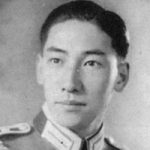 Yang Kyoungjong was a Korean man with an incredible story. In 1938, when he was 18 years old, Kyoungjong was in Manchuria when he was forced into the Kwantung Army of the Imperial Japanese Army to fight against the Soviet Union. It was the outbreak of World War II, and I suppose the Japanese decided they would be better off to make him soldier than to let him languish in a prisoner of war camp. So, fight he did. Korea was ruled by Japan at that time, and Kyoungjong really had no choice to to follow orders.
Yang Kyoungjong was a Korean man with an incredible story. In 1938, when he was 18 years old, Kyoungjong was in Manchuria when he was forced into the Kwantung Army of the Imperial Japanese Army to fight against the Soviet Union. It was the outbreak of World War II, and I suppose the Japanese decided they would be better off to make him soldier than to let him languish in a prisoner of war camp. So, fight he did. Korea was ruled by Japan at that time, and Kyoungjong really had no choice to to follow orders.
During the Battle of Khalkhin Gol, things weren’t going well for the Japanese army, and Kyoungjong was again captured…this time by the Soviet Red Army. He was sent to a Gulag labor camp. While he was there, and with Soviet manpower shortages being what they were, Kyoungjong was presses into service in the Soviet army in 1942. He, along with thousands of other prisoners, were told to fight with the Red Army against Nazi Germany. He was sent to the Eastern Front of Europe.
Somehow, Kyoungjong managed to always be in the wrong place at the wrong time. In 1943, he was once again captured, this time by the Wehrmacht soldiers in eastern Ukraine during the Third Battle of Kharkov. He  was pressed into service again, and told that he had joined the “Eastern Battalions” to fight for Germany. Kyoungjong was sent to Occupied France to serve in a battalion of former Soviet prisoners of war on the Cotentin peninsula in Normandy, close to Utah Beach. I’m sure he wondered which army he was really a part of.
was pressed into service again, and told that he had joined the “Eastern Battalions” to fight for Germany. Kyoungjong was sent to Occupied France to serve in a battalion of former Soviet prisoners of war on the Cotentin peninsula in Normandy, close to Utah Beach. I’m sure he wondered which army he was really a part of.
During the D-Day landings in northern France by the Allied forces, Kyoungjong was captured by paratroopers of the United States Army in June 1944. The American Army thought he was a Japanese soldier in German uniform at first. At the time, Lieutenant Robert Brewer of the 506th Parachute Infantry Regiment, 101st Airborne Division, reported that his regiment had “captured four Asians in German uniform after the Utah Beach landings, and that initially no one was able to communicate with them.” The good news for Kyoungjong was that he was not going to again be expected to fight with a different army. He was first sent to a prison camp in Britain and later transferred to a camp in the United States.


One Response to Which Army?